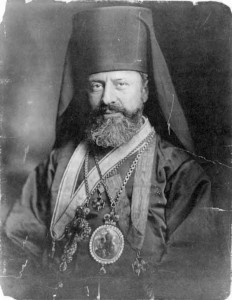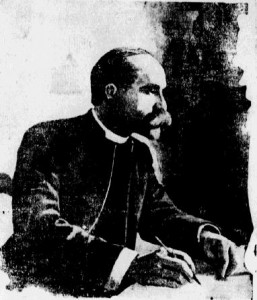Last week, we discussed St. Raphael’s involvement with the Episcopal Church — his role in an Orthodox-Anglican dialogue group, and his June 1910 letter permitting Episcopalian clergy to minister to Syrian Orthodox people in limited circumstances. Later that year, one of St. Raphael’s top assistants, Fr. Ingram Nathaniel Irvine, wrote a lengthy open letter, warning the Orthodox bishops in America of the Episcopalian threats to Orthodoxy. “Permit me to remind you, Fathers, that already the decks of the Protestant Episcopal battleships are cleared for action,” Irvine wrote. “Her Diocesan regiments, well equipped and united, are in ecclesiastical array.” He continued:
I say with solemn earnestness that the battle will be fought in the United States between Orthodoxy, by which I mean “the faith once for all delivered unto the saints,” as saith St. Jude, and now alone kept by the Holy Orthodox Church of which you and I have the honor of being members, and all others, whether Roman Catholic, Anglican, Protestant, Unitarian or Nothingarian.
Irvine’s full letter is a highly significant document, and we will examine it in detail in the future. For now, suffice it to say that Irvine warned the Orthodox bishops that these seemingly harmless ecumenical dialogues posed serious threats to the survival of Orthodoxy in America. In part, this is because such dialogues seemed to legitimize the Episcopal Church in the eyes of the untrained Orthodox layman. Combined with statements such as St. Raphael’s June 1910 letter, the door was opened for Episcopalians to say to the Orthodox, “Look, we are just like you! You needn’t worry about seeking an Orthodox priest; come to our churches instead!” Irvine warned,
Samson lost his strength when he played the fool with Delilah, who pretended love so as to disarm him of his source of power over the foes of the ancient Israel. We Orthodox, both Clergy and Laity, will lose all our strength if for the sake of society blandishments, whether clerical or lay, of those who hold not the Faith, betray our trust. Sooner or later we will find the Philistines rushing in upon us.
On September 25, 1911 — so, 15 months after issuing his letter of permission to the Episcopalians — St. Raphael formally withdrew from the Anglican and Eastern Orthodox Churches Union. He sent a letter to the Union, tendering his resignation, and then sent a pastoral epistle to his flock. Irvine’s influence is apparent in both letters. In fact, it is clear, based on the language and writing style, that Irvine himself authored both documents. This is not to say that St. Raphael had no hand in their content; on the contrary, he most certainly agreed with everything expressed in the letters, and he signed his name to both. But given Irvine’s position as a trusted advisor, his vast knowledge of Anglicanism, and his considerable writing ability, it is understandable that St. Raphael would delegate to him the actual task of letter-writing. (Incidentally, I can document at least one other instance in which Irvine ghost-wrote a letter for St. Raphael, and he almost certainly did the same for St. Tikhon on at least one occasion.)
To the letters. In the first, to the Union itself, St. Raphael (via Irvine) said,
There is a great and growing misunderstanding on the part of the Laity to wit, that, there is actually a union, or that, there will be, in the very near future, a corporate Union, between the Protestant Episcopal Church and the Holy Orthodox in America at least. The result is that the Laity in some sections are being confused in their doctrinal belief as well as growing careless about other requirements of the Holy Orthodox Church. In fact they neither know what to believe nor to reject, – much less which Church it is their duty to sustain.
To make matters worse, as we noted above, some Episcopalian clergymen had taken too far the limited permission in St. Raphael’s June 1910 letter:
Some of the Protestant Episcopal Clergy have taken upon themselves, through misunderstanding, to offer their services to Orthodox people, when even Orthodox Priests were within calling distance to minister to them; thus conveying the idea that, they, the Protestant Episcopal Clergy, were accepted as Holy Orthodox and that, there was no need of the ministrations or pastoral care of their own Orthodox Bishops and Clergy.
Thus, St. Raphael respectfully withdrew from the Union. He followed this with a 2200-word pastoral epistle. He (again via Irvine) stated, “I am convinced that the doctrinal teaching and practices, as well as the discipline, of the whole Anglican Church are unacceptable to the Holy Orthodox Church.” Therefore, “I direct all Orthodox people residing in any community not to seek or to accept the ministrations of the Sacraments and rites from any clergy excepting those of the Holy Orthodox Catholic and Apostolic Church.” But St. Raphael didn’t stop there. It was not enough for the Orthodox to avoid the ministrations and sacraments of non-Orthodox bodies. He went on, “I further direct that Orthodox Christians should not make it a practice to attend the services of other religious bodies, so that there be no confusion concerning the teaching or doctrines.”
The full text of this letter may be found at this link.
Now, imagine the position of St. Raphael. He was a vice president of the Anglican and Eastern Orthodox Churches Union. He had frequent dealings with Episcopalians, as did his associates in the Russian Archdiocese. Talk of union was in the air. His June 1910 letter was well-received by Episcopalians and not publicly criticized by any Orthodox people. But he saw, and Irvine called attention to, the error of that 1910 letter. It must have taken immense humility for St. Raphael to rescind his permission and withdraw from the Union. I’m sure he had many long discussions with Irvine beforehand, and he must have ultimately instructed Irvine to draft two letters on his behalf. St. Raphael read them, and perhaps edited them (for an unadulterated Irvine letter could be abrasive).
The whole affair must have been painful for St. Raphael, but, a century later, I am amazed at his openness and humility. As the June 1910 letter proves, he was not perfect, but his actions in 1911 are evidence of his genuine love for his flock. He was a great bishop.


…the door was opened for Episcopalians to say to the Orthodox, “Look, we are just like you! You needn’t worry about seeking an Orthodox priest; come to our churches instead!”
I believe this state of confusion has existed up until today. A Greek-American actress I knew was insistent that the ECUSA and GOA were in full communion with each other – her Episcopal priest had told her so and he was very educated. She had no qualms at all in attending and communing at her ECUSA church on the Upper West Side (where there is also a GOA church) and communing in Orthodox churches when she visited Greece.
One can make innumerable arguments against her contention, of course, but it underlines Fr. Irvine’s contention that “such dialogues seemed to legitimize the Episcopal Church in the eyes of the untrained Orthodox layman.”
There is a practical as well as a dogmatic stance against ‘ecumenism’.
^That goes for the “Orthodox in communion with Rome,” the lifting of the 1054 anathemas, and the Vatican extending communion to the Orthodox as well.
It would seem that New England was not the only dangerous place, and the Episcopalians the only dangerous denomination-Minutes of the General Assembly of the Presbyterian Church in the United States By Presbyterian Church in the U.S. General Assembly (1897):
“We quote from the Presbytery of New Orleans: “The Presbyterial force has been materially strengthened by the addition of several consecrated and able young men, who, in the pastorate and in the evangelistic field, have been doing admirable and effective work. Our missions in New Orleans among the Chinese, the seamen and the negroes, are all flourishing.
Converted Chinamen are from time to time returning from this Christian school to their fatherland, and constituting new centres of evangelistic influence in that great pagan country. At a recent communion in the Canal Street Church, under whose care this mission is, eighteen of these saved orientals sat down at the table of the Lord. A number of Syrians, small shop-keepers in New Orleans, expressed through one of their number, although members of the Greek church, a desire to become Protestants.”
http://books.google.com/books?id=fKgRAAAAYAAJ&pg=PA60&dq=New+Orleans+Greek+Church&hl=en&ei=iakRTO2_HMH_nQfH2KSRAw&sa=X&oi=book_result&ct=result&resnum=3&ved=0CDEQ6AEwAjhQ#